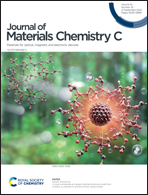Copper halide anion engineering for p-channel electrolyte-gated transistors with superior operational reliability†
Abstract
Recently, copper iodide (CuI) has attracted significant attention as a promising inorganic p-type semiconductor for thin-film devices, including solar cells, sensors, and thin-film transistors owing to its high carrier density, high hole mobility, and low-temperature solution processability. However, electronic devices based on CuI tend to suffer from poor operational stability and device performance, because the volatile and unstable iodine can sublime or disintegrate during thermal annealing and device operation, leading to degradation of device performance. In this study, we demonstrate a facile route to enhance the operational performance of metal halide-based p-channel transistors by anion doping. Nonvolatile bromine (Br) ions were introduced to the CuI semiconductor to suppress iodine sublimation or degradation, and Br-doped CuI composite semiconductors were solution-processed with thermal annealing at a low temperature (∼100 °C). By using Br-doped CuI semiconductors, electrolyte-gated thin-film transistors (EGTs) operating at low voltages (<1 V) were successfully fabricated and the EGTs using the 20 mol% Br-doped CuI semiconductor exhibited a high average carrier mobility of 6.3 cm2 V−1 s−1. More importantly, owing to the nonvolatile Br ions, the operational stability of the EGTs with Br-doped CuI was significantly improved compared to the EGT that utilized an undoped pristine CuI semiconductor.



 Please wait while we load your content...
Please wait while we load your content...